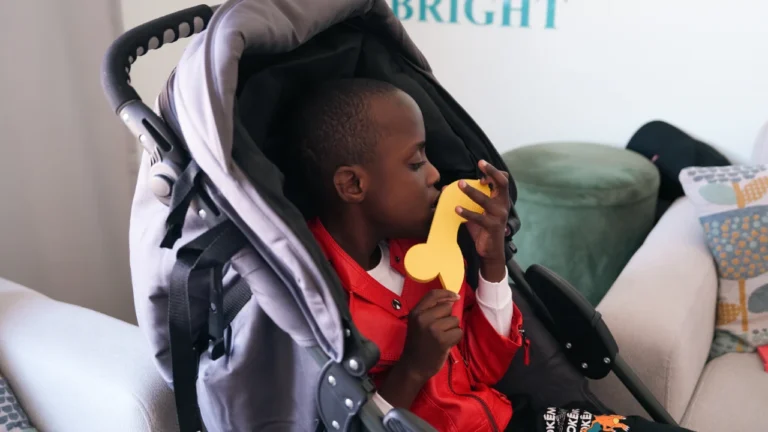The Best Fluffy Pancakes recipe you will fall in love with. Full of tips and tricks to help you make the best pancakes.
A Century‑Old Drug with New Potential
Suramin—a drug first developed in 1916 to combat African sleeping sickness—has recently emerged in autism research. Discovered by Dr. Robert Naviaux at UCSD, this antipurinergic agent offers a unique therapeutic approach to Autism Spectrum Disorder (ASD) by targeting metabolic and inflammatory pathways in the brain .
For parents drawn to cutting-edge treatments like stem cell therapy for autism, understanding suramin’s role offers a richer perspective on the evolving landscape of neurodevelopmental interventions.
Table of Contents
1. What Is Suramin and How Does It Work?
Suramin is a non-selective antagonist of purinergic signaling pathways, blocking ATP receptors (P2X and P2Y) . According to Dr. Naviaux, it functions like “removing the brakes” from halted developmental pathways—it doesn’t reroute development but re-enables progression .
This aligns with the Cell Danger Response (CDR) hypothesis, suggesting that persistent metabolic stress traps brain cells in a defensive state, disrupting normal growth. Suramin may temporarily reverse this, allowing natural developmental processes to resume .
2. Preclinical and Early Clinical Evidence
Animal Studies
In mouse models—especially Fragile X and maternal immune activation—suramin corrected neuroinflammation, metabolic changes, and core autistic-like behaviors .
Phase I/II SAT‑1 Trial (2017)
A single low‑dose IV infusion of suramin in five children showed significant improvements in language, social interaction, and repetitive behaviors compared to placebo . The trial confirmed safety and metabolic impact, raising hope for further validation.
Phase II Trial (2023)
In a larger 14-week, randomized, placebo-controlled study involving 52 boys (ages 4–15), 10 mg/kg suramin showed a numeric improvement of –12.5 versus –8.9 in the Aberrant Behavior Checklist, although this was not statistically significant . Notably, Clinical Global Impressions scores improved significantly in the lower-dose group (2.8 vs. 1.7, p = 0.016) .
3. Safety Profile and FDA Status
While suramin is FDA-approved for African sleeping sickness, it is not approved for autism . Side effects range from nausea and fatigue to rare occurrences of low blood pressure and kidney issues . Dr. Naviaux strongly warns against off-label use due to toxicity risks without proper monitoring .

4. Where Suramin Fits Within Autism Therapies
Suramin operates at a metabolic signaling level, distinct from behavioral therapies (ABA, speech therapy) or cellular-level stem cell treatments. It aims to reset inflammatory and energetic pathways, which could enhance the effectiveness of both behavioral and regenerative interventions.
While Stem Cell Therapy for Autism Research offers hope through immune modulation, tissue repair, and neural support, suramin highlights how targeting cellular stress responses can also support development .
5. What’s Next for Suramin in Autism?
Upcoming trials—such as STAT‑2A (KZ101)—will test repeat dosing over 30 weeks in larger cohorts . Real-world impact hinges on future results demonstrating consistent clinical and metabolic improvements, and ensuring long-term safety.
If suramin’s approach proves robust, it may lead to new targeted antipurinergic therapies that blend precision and safety .
Conclusion: A Metabolic Perspective Worth Watching
Suramin is not a cure—but it’s a meta-therapeutic tool that targets a root mechanism: cellular stress. While distinct from stem cell therapy, it complements regenerative approaches by potentially clearing biological impediments to development.
Careful follow-up in Stem Cell Therapy Autism Clinical Trials, alongside suramin’s trajectory, may redefine the therapeutic standards for ASD—integrating metabolic tools with regenerative and behavioral strategies.
👉 Families interested in holistic autism therapy are advised to follow updates on stem cell clinics as well as antipurinergic trial outcomes, weighing safety, access (including clinics offering suramin or KZ101), and cost considerations.
Q&A: Your Suramin Questions Answered
Is suramin FDA-approved for autism?
No. Suramin is only FDA-approved for parasitic diseases. Use in autism remains experimental and restricted to clinical trials.
How effective is suramin in autism cases?
Preliminary DI improvements and behavioral changes were observed in animal and early human trials, but larger studies are still needed for confirmation.
Are there side effects?
Yes—common ones include fatigue, nausea, and headache; rare but serious issues include kidney dysfunction or hypotension.
Can I use suramin alongside stem cell therapy?
There’s no direct research on combined use yet. Each therapy affects different pathways, so coordination under clinical guidance is necessary.
When will we see suramin available for autism outside trials?
Only after further Phase II/III trials and regulatory review. The STAT‑2A study may pave the way for broader protocols in the next few years.








